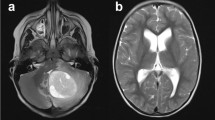Abstract
A prospective study was undertaken of all children referred to the Hospital for Sick Children with a provisional diagnosis of shunt blockage over a 5-month period. Fifty-two admissions were recorded, relating to 45 children, 5 of whom had multiple admissions. Only 19 of the 52 admissions led to a final diagnosis of shunt malfunction. No source of referral, whether by the child's general practitioner or from another hospital, was found to be more accurate than direct referral by the parents to the neurosurgical ward. Headache, vomiting and irritability were not significant indicators as to whether the child's shunt was actually blocked, and nor was the duration of the symptoms. Drowsiness was a significant, but not definite, indicator of shunt blockage, while pyrexia made it more likely that the patient had an alternative diagnosis. In 35 of the admissions a computed tomographic scan was performed: a normal scan, unchanged from previous scans, did not reliably exclude the diagnosis of shunt blockage. Percutaneous manometry via the reservoir of the shunt system was performed during 26 admissions: this investigation produced no false positives nor false negatives, but was equivocal in 5 cases, all of which were found at surgery to have a definite shunt blockage. The accuracy of the diagnosis of shunt blockage made prior to referral to a neurosurgical unit is discussed, together with the implications for resource use.
Similar content being viewed by others
References
Ashkenazi E, Umansky S, Constantini S, Israel Z, Polliack G, Gomori M (1992) Fever as the initial sign of malfunction in non infected ventriculoperitoneal shunts. Acta Neurochir (Wien) 114:131–134
Colli BO, Starr EM, Martelli N (1981) Surgical treatment of hydrocephalus in children. II. Complications. Arch Neuropaediatr 39:400–419
Peacock WJ, Currer TH (1984) Hydrocephalus in childhood. A study of 440 cases. S Afr Med J 66:323–324
Pople IK, Quinn MW, Bayston R (1990) Morbidity and outcome of shunted hydrocephalus. Z Kinderchir 45 [Suppl 1]:29–31
Pople IK, Quinn MW, Bayston R, Hayward RD (1991) The Doppler pulsatility index as a screening test for blocked ventriculoperitoneal shunts. Eur J Pediatr Surg 1 [Suppl 1]: 27–29
Rekate HL (1991–1992) Shunt revision: complications and their prevention. Pediatr Neurosurg 17:155–162
Sainte-Rose C, Piatt JH, Renier D, Pierre-Kahn A, Hirsch JF, Hoffman HJ, Humphreys RP, Hendrick EB (1991–1992) Mechanical complications in shunts. Paediatr Neurosurg 17:2–9
Shapiro K, Fried A (1986) Pressurevolume relationships in shunt dependent childhood hydrocephalus: the zone of pressure instability in children with acute deterioration. J Neurosurg 64:390–396
Author information
Authors and Affiliations
Rights and permissions
About this article
Cite this article
Watkins, L., Hayward, R., Andar, U. et al. The diagnosis of blocked cerebrospinal fluid shunts: a prospective study of referral to a paediatric neurosurgical unit. Child's Nerv Syst 10, 87–90 (1994). https://doi.org/10.1007/BF00302769
Received:
Issue Date:
DOI: https://doi.org/10.1007/BF00302769




